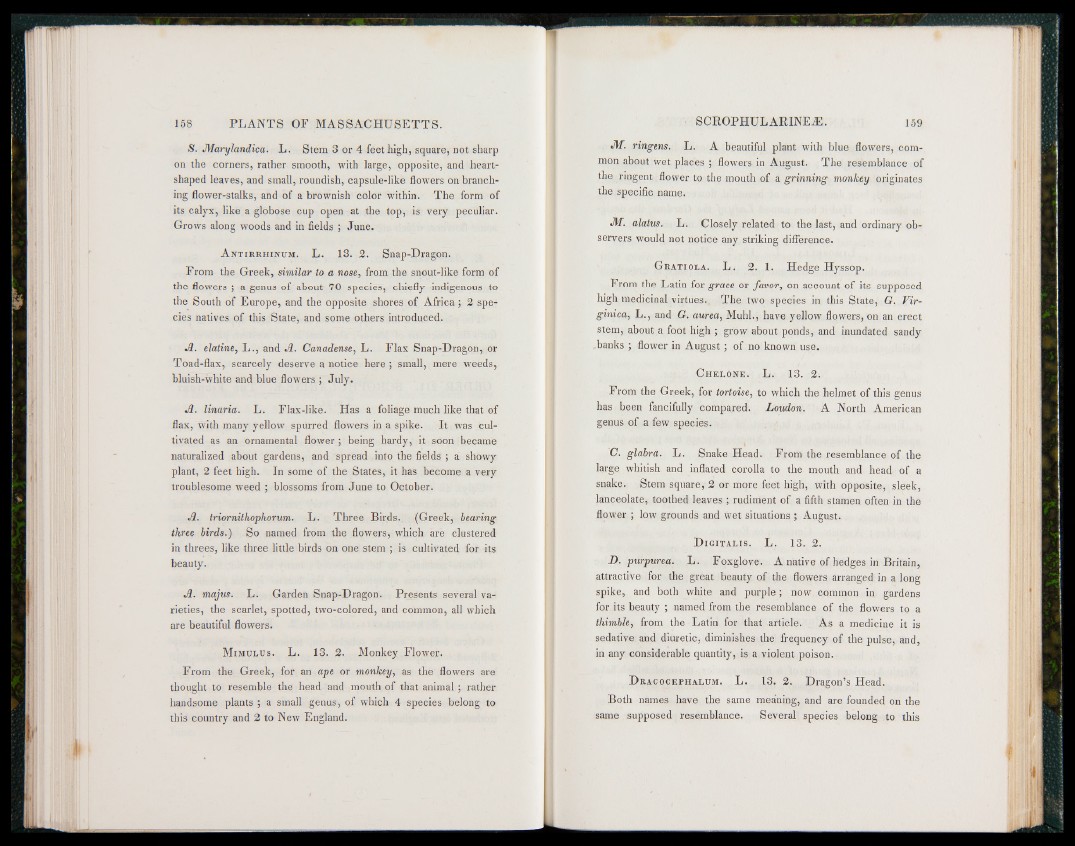
iS. Marylandica. L. Stem 3 or 4 feet high, square, not sharp
on the corners, rather smooth, with large, opposite, and heart-
shaped leaves, and small, roundish, capsule-like flowers on branching
flower-stalks, and of a brownish color within. The form of
its calyx, like a globose cup open at the top, is very peculiar.
Grows along w'oods and in fields ; June.
A n t irrhinum. L. 13. 2. Snap-Dragon.
From the Greek, similar to a nose, from the snout-like form of
the flowers ; a genus of about 70 species, chiefly indigenous to
the South of Europe, and the opposite shores of Africa; 2 species
natives of this State, and some others introduced.
Jl. elatine, L ., and A. Canadense, L. Flax Snap-Dragon, or
Toad-flax, scarcely deserve a notice here ; small, mere weeds,
bluish-white and blue flowers ; July.
A. linaria. L. Flax-like. Has a foliage much like that of
flax, with many yellow spurred flowers in a spike. It was cultivated
as an ornamental flower; being hardy, it soon became
naturalized about gardens, and spread into the fields ; a showy
plant, 2 feet high. In some of the States, it has become a very
troublesome weed ; blossoms from June to October.
A. triornithophorum. L. Three Birds. (Greek, bearing
three birds.) So named from the flowers, which are clustered
in threes, like three little birds on one stem ; is cultivated for its
beauty.
A. majus. L. Garden Snap-Dragon. Presents several varieties,
the scarlet, spotted, two-colored, and common, all which
are beautiful flowers.
M imulus. L. 13. 2. Monkey Flower.
From the Greek, for an ape or monkey, as the flowers are
thought to resemble the head and mouth, of that animal ; rather
handsome plants ; a small genus, of which 4 species belong to
this country and 2 to New England.
<M. ringens. L. A beautiful plant with blue flowers, common
about wet places ; flowers in August. The resemblance of
the ringent flower to the mouth of a grinning monkey originates
the specific name.
Af. alatus. L . Closely related to the last, and ordinary observers
would not notice any striking difference.
G ratiola. L . 2. 1. Hedge Hyssop.
From the Latin for grace or favor, on account of its supposed
high medicinal virtues.. The two species in this State, G. Vir-
ginica, L., and G. aurea, Muhl., have yellow flowers, on an erect
stem, about a foot high ; grow about ponds, and inundated sandy
banks ; flower in August; of no known use.
C h e lo n e . L. 13. 2.
From the Greek, for tortoise, to which the helmet of this genus
has been fancifully compared. Loudon. A North American
genus of a few species.
C. glabra. L. Snake Head. From the resemblance of the
large whitish and inflated corolla to the mouth and head of a
snake. Stem square, 2 or more feet high, with opposite, sleek,
lanceolate, toothed leaves ; rudiment of a fifth stamen often in the
flower ; low grounds and wet situations ; August.
D igitalis . L. 13. 2.
D. purpurea. L. Foxglove. A native of hedges in Britain,
attractive for the great beauty of the flowers arranged in a long
spike, and both white and purple; now common in gardens
for its beauty ; named from the resemblance of the flowers to a
thimble, from the Latin for that article. As a medicine it is
sedative and diuretic, diminishes the frequency of the pulse, and,
in any considerable quantity, is a violent poison.
D racocephalum. L. 13. 2. Dragon’s Head.
Both names have the same meaning, and are founded on the
same supposed resemblance. Several species belong to this